This long and rambling post, or essay, maybe, began in Melbourne, as I was sitting on a bench in the vibrant Fitzroy North neighborhood with a cup of coffee and a beautiful pain au chocolat. Spring had arrived properly, I had been there for 3-4 weeks, and so much had happened already, my head and body full of impressions.
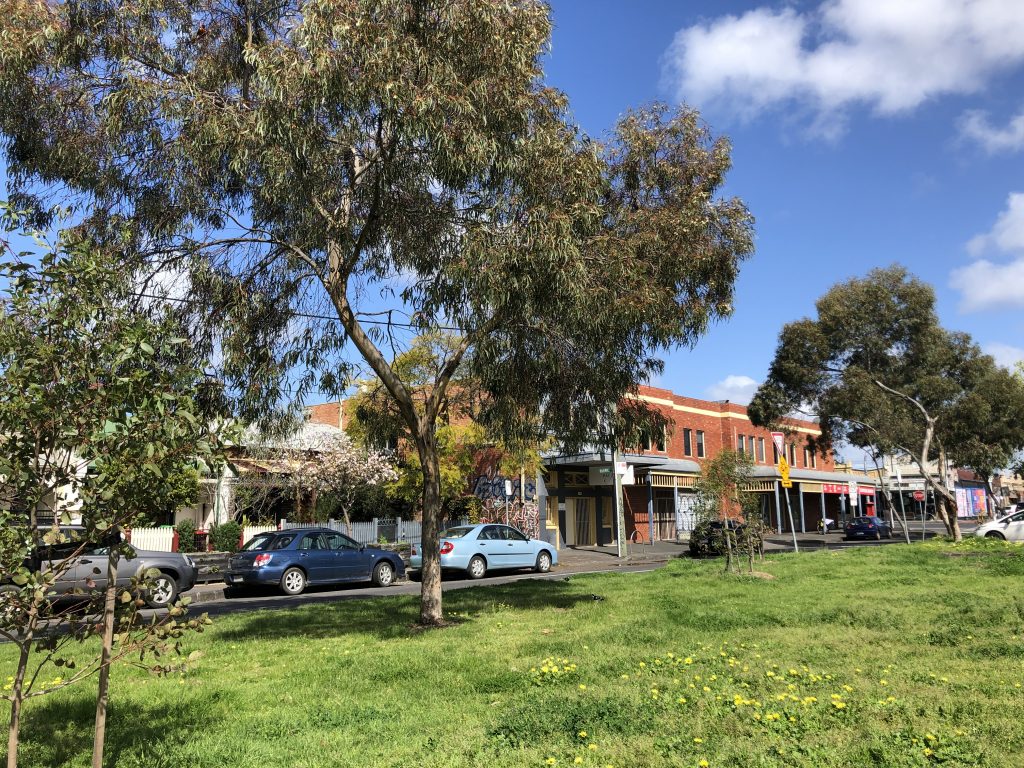
That Sunday on the bench, I started to jot down messy notes on my phone, trying to collect my thoughts from these first intense weeks. It had been a wild ride that had already changed the trajectory of my PhD to a far greater degree than I could ever have expected or hoped for – and I had a feeling that we were merely getting started (we certainly were, but more on that later)
Over the course of my PhD project, I have become interested in the nature of the PhD itself, what it is, but even more so, what it could be. At first, unwittingly, fumbling, simply trying to find a way, my way, but I am now, slowly, starting to engage more consciously with what Frances Kelly labels the “PhD imaginary”:
a set of ideas expressed and perpetuated in stories, images and legends, held by PhD students and graduates but also in the repertory of ordinary folk or society at large, and which enable particular practices, regarded as ‘normal’ or how things usually go
(Kelly, Frances (2017): The Idea of the PhD – The doctorate in the twenty-first-century imagination, p. 5).
As Kelly further argues, the available PhD imaginaries “effects individuals’ decisions about where to go to do a PhD, what to study, how to conduct themselves, how to be.” (Kelly, 2017, p. 119). These last few words – how to be? – are perhaps the most unsettling and confounding question of the entire endeavour.
How to be a PhD Candidate, a researcher, a human.
A PhD project can be seen as a fixed period of time, three years in this case, and a clearly delineated body of work, a neat package you put a bow on and hand over for someone to assess and critique. If seen in this light, it is easy to become discouraged by all the stories of dissertations never being read by anyone except the committee (who don’t have much choice), fading away in a drawer or on a shelf, if not simply drifting off into the digital void, to find its final resting place in the mythical PDF graveyard.
Even if those stories are not entirely true, even if there is indeed more for the work to do in the world – and one can hope – I have come to realise that the text itself is only a smaller part of undertaking a PhD project. More than that, it is a journey, an adventure, a process of becoming and it is, must be, transformative. I am no longer the same person as I was when I set sails. If this claim is true, it begs the question what I have become? How have I been transformed?
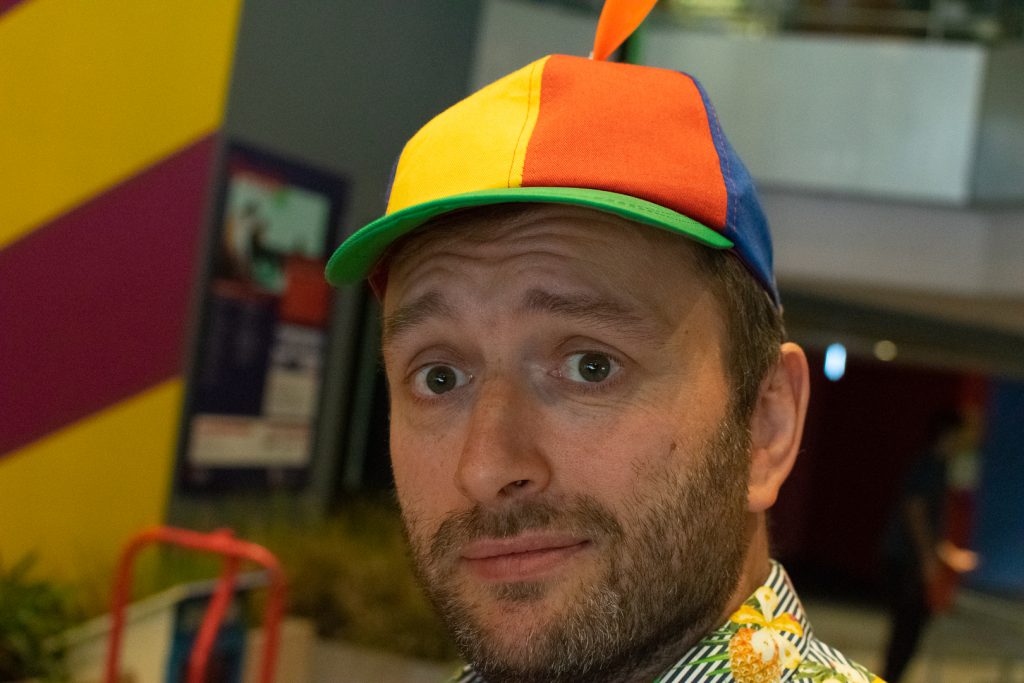
While I can never really answer these questions in a satisfactory manner, I have to try, to keep trying, because it might reveal the identities that are now available to me as a researcher, as well as the position from which I engage with the world.
I embarked on the journey thinking I knew what research was, and what kind of researcher I would be. I had my MA, and more importantly, I had been working with researchers in a number of interdisciplinary projects over the years. I had many friends who were researchers and even my dear partner, Camilla, had finished her PhD before we met each other more than a decade ago. I had been reading loads of research – papers, articles, books – and I had been drawing on research in much of my writing, though my style was usually rather informal and playful (not unlike this thing you’re reading now).
It would come to surprise me how little I actually knew, almost like back in the day when I naively thought that a few years of French classes were enough to be fluent in French (I do remember the word “chauffe-eau”, though). Oh, how little did I know. It was if all my knowledge only scratched the surface, and had not yet become an embodied, integrated part of who I was. It is evidently true, as Lisa Grocott writes in her recent book, that “the transformative shifts operate in the margins – they are experienced at an intrapersonal level and can take their time to bloom” (Grocott, 2022, p. xx)
In fact, when I really became interested in democracy some years ago, Camilla laughed and asked why I hadn’t just listened to her, or better yet, read some of her research on that topic. We all move at different speeds, following different rhythms, arriving at different times, if at all.
Along the trajectory of this PhD, I have been grappling with the nature of research and the possible identities available to me as a researcher. Or, more to the point, the identities I believed to be available. Is a proper researcher someone who knows, an expert who has answers, who can tie all the theory and empirical findings together in a clear way, is it someone who strives to tell a coherent, compelling story that eliminates doubt and calms the nerves? Is it pretending that when I wrote this or that article, I knew where I was going, or even what I was doing? Is research showing something to be true – such as making the claim that yes, play is indeed democratic?
Though perhaps a bit of a caricature, this voice has haunted me for the first two years of this project. It still does, but much less so now. It was always there, at the back of my head, echoing some distorted academic ideals that were both a part of me and in the starkest of contrasts to how I saw myself. It was not a rational voice, of course, but it pretended to be. It insisted it was in the know. It played the role of reason, claiming to know where we were going, and what we had to do to get there, but in the end, it turned out to be a horrible tour guide.
Frustration and despair followed. Underneath the doubts and insecurities about the project, the experiments, the data, I have repeatedly had to confront my doubts and insecurities about myself, my own inadequacies, and flaws, as a researcher and as a person. I have found myself trapped in the contradictions between the kind of research I want to do and the kind of research I feel like I should do. Even more complicated, there is a conflict between the kind of researcher I want to be and the kind of researcher I feel like I should be. My own hopes and dreams contrasted by my conceptions of the right way to do research.
To my delight, as I started to listen, really listen, I heard other voices. At first, the voices were faint, like a whisper in the wind, often drowned out by much louder voices, by all the noise. Then I realised that the faintness of the voices were not a sign of weakness, it was no reason not to listen, on the contrary, they were vague by intention. They didn’t believe it necessary to shout, to proclaim to know the truth, to hold the answer, merely to embrace the doubt, to ask the questions. In time, as I made an effort to hear them, the faint voices grew in number, making themself impossible for me to keep ignoring. Something was happening, slowly, at first, but then faster, and irreversibly so. Cracks appeared, the walls crumbled, and I started to see how misguided my initial preconceptions were.
“Ring the bells that still can ring
Leonard Cohen – Anthem
Forget your perfect offering
There is a crack, a crack in everything
That’s how the light gets in”
Maybe the tectonic plates of academia are indeed shifting, or maybe all we have are the small cracks, just enough to let in the light. I can’t quite tell how much all this amounts to in the grander scheme of things, is it just a slight tremor, almost imperceptible ripples on the surface or is it something more, deeper and more profound? I don’t know, but for me, it is enough, it gives me hope and grants me the confidence I need to keep going.
It is the voices in the literature, where I started to understand how many researchers were also struggling, trying to come to terms with limitations and inadequacies. It is in insisting that also in research, the unexpected, the detours, all that we can’t control, must be embraced and cherished:
A creative research practice springs from a curious, sensitive and playful life as a human being. Plans are fine. However, if we are preoccupied with how things were supposed to play out, we may not see and take in the inspirational sources right in front of us
Wegener, Meier & Maslo (2018): Cultivating Creativity in Methodology and Research: In Praise of Detours, p. 13
It is the scholars who call for humility, embracing and saluting the modesty of our contributions:
“By acknowledging the influence of design as limited, I hope to offer a theorization of design that recognizes how designers might aspire to participate in democracy, while remaining self-effacing about the effects of that participation. This does not mean such design is useless or token. Rather, I merely seek to recognize that such design is often modest.”
Disalvo, Carl (2022): Design as Democratic Inquiry Putting Experimental Civics into Practice, p. 7
Or when John Law argued that method and research should focus more on:
“creating metaphors and images for what is impossible or barely possible, unthinkable or almost unthinkable. Slippery, indistinct, elusive, complex, diffuse, messy, textured, vague, unspecific, confused, disordered, emotional, painful, pleasurable, hopeful, horrific, lost, redeemed, visionary, angelic, demonic, mundane, intuitive, sliding and unpredictable”
Law, John (2004): After Method Mess in social science research, p. 6
This pattern continues, also in the so-called “new materialism”, where non-human bodies are seen to actively counter the popular belief that we, humans, are somehow in control:
“I will emphasize, even overemphasize, the agentic contributions of nonhuman forces (operating in nature, in the human body, and in human artifacts) in an attempt to counter the narcissistic reflex of human language and thought. We need to cultivate a bit of anthropomorphism—the idea that human agency has some echoes in nonhuman nature—to counter the narcissism of humans in charge of the world.”
Bennett, Jane (2010): Vibrant Matter: A Political Ecology of Things, p. xvi
And more and more, it is in the many voices, previously subdued, that critique the dominant Global North / Eurocentric / Western culture and way of conceiving the world:
“Patriarchal culture is defined as characterized by actions and emotions that value competition, war, hierarchies, power, growth, procreation, the domination of others, and the appropriation of resources, combined with the rational justification of it all in the name of truth. In this culture, which engulfs most modern humans, we live in mistrust and seek certitude through control, including control of the natural world.”
Escobar, Arturo (2017): Designs for the Pluriverse Radical Interdependence, Autonomy, and the Making of Worlds, p. 41
And it is in the writing of our friends in Melbourne (I have already mentioned Lisa’s book, but there’s so much more):
we live in and grapple with worlds that are ongoingly emergent and changing configurations of things and processes. In such a world we have no basis upon which to be confident that we can know what will happen next in the immediate or far future, or that we can take any measures that could be absolutely guaranteed to determine or change our futures.
Pink, Akama, & Sumartojo (2018): Uncertainty and Possibility, pp. 4-5)
But it is also the voices in poetry, the art and the songs I listen to. Like the lyrics Nick Cave wrote so beautifully in “Fireflies”, as he was trying to cope with the emotional ramifications of his son’s death, realising how little we can actually control:
And we lie among our atoms and I speak to you of things
Nick Cave – Fireflies
And hope sometimes that maybe you will understand
There is no order here and there is no middle ground
Nothing can be predicted and nothing can be planned
A star is just a memory of a star
Across all these different domains and forms of expression, I am seeing the contours of a way of being a human and, consequently, a researcher that is less strategic, less concerned with outcomes and impact, less in demand of control, less assertive, more present, gentle, sensitive, attuned, caring.
In addition to everything I have read, whatever little confidence I have now stems from the encounters with other people, other researchers, those with much more experience than me as well as fellow PhD students. They say a PhD project is a solitary affair, and while it has been at times, I only made it this far because it is also the opposite: an opportunity, a series of opportunities, to get close to the hearts and minds of other researchers. When I have had even the most transient glimpses of “radical happiness”, as Lynne Segal puts it, I can only attribute that to the shared experiences, the togetherness and the sense of community. Staying with Segal for a little while longer, it is the “collective joy” that resonates the deepest, “when we are most fully absorbed or lost in something clearly bigger than ourselves, free for a while from exactly that self-monitoring that disciplines our daily lives.” (Segal, 2018, p. 263).
I cannot point to any one specific experience that completely altered my perceptions, because it has been a slow, emerging transformation that is still ongoing, but I can say for certain that something significant happened during my research stay in Melbourne (as well as later, now, in Canberra). In fact, you can substitute “Singapore” with “Melbourne” in the following, and Meier quite accurately describes my own experience:
I travelled across the world to learn about the way I think and write, something that was in me all along. Strangely, this feels right: as if this insight had to be had in Singapore, as if it was somehow there, waiting for me to arrive.
Meyer p. 146-147 in Wegener, Meier & Maslo (2018): Cultivating Creativity in Methodology and Research: In Praise of Detours
It seems almost banal, but simply stepping out of the ordinary circles, routines and rhythms of everyday life allowed me to see myself and my work in a new light. Maybe it is a form of “boundary crossing”? At home, I can be stuck in the same unhealthy and unproductive patterns for long periods of here; here, I have been destabilised, as my understanding of myself and my work have become thoroughly unsettled.
I have also been reminded that CounterPlay, the play festival I started that so profoundly shaped the trajectory of my life and inspired my PhD-project, is somehow still alive, even down here, so far away from home. I have met a few people who not only remember the event, but talk about it fondly, and seems to still feel connected to the people and the community. This has been truly encouraging and heartwarming.
When I met with Troy Innocent from Future Play Lab at RMIT, we immediately started talking about CounterPlay, and he suggested we should also run the festival in Melbourne, before he invited me to talk about CounterPlay and my research at the “Play About Place” seminar during Melbourne Games Week.
That is far more CounterPlay than I had expected. I am here because of my PhD project, right?
Yes and no. It was a wonderful opportunity to pause and reflect, which made me realise how things are more connected than I thought. The PhD project is not a new start, not something different, somehow separate and isolated from my lived experience. Maybe CounterPlay is not merely something that inspired my PhD project, and then that’s it, but rather something that remains entangled and embedded in more ways than I can comprehend, still speaking back and giving shape. And maybe that is not a weakness, but a strength.
These questions also surfaced during conversations with Stacy Holman Jones in Melbourne. She has published extensively on autoethnography and the use of stories, also personal stories, in academic writing. As she succinctly told me and Lotte when we met with her:
“I’m a storyteller, that’s my job”
In this one, short and unassuming sentence, she seemed to capture her whole oeuvre as an academic and a human.
Up until now, I have found it particularly challenging to talk and write about myself, using my own person, my own body, my own values, and worldviews. However, while Cox et al claim that “origin stories are the experiences that go un-noted in many academic genres” (Badenhorst et al., 2021, p. 147), there is no escaping that this project and most of my thinking around play has grown out of my previous experiences, and more specifically my work with the CounterPlay festival.
Writing about myself and my own experiences in this way initially simply felt too “self-absorbed—academic navel gazing” (Smith et al., 2017, p. 46) in a very uncomfortable way. At the same time, I also want to “acknowledge the fact that we need to use and be honest about our own bodily involvements and reactions” rather than “covering it up and trying to disguise the fact that researchers also have bodies with a capacity to be affected” (Timm Knudsen & Stage, 2015, p. 17).
I was thrilled to realise that I had, of course, completely misunderstood the nature of autoethnography; “perhaps autoethnography is not about the self at all; perhaps it is instead about a wilful embodiment of “we.”” (Spry, 2016, p. 15). Coming back to Stacy, she makes a similar argument, when she elaborates that “autoethnography does not speak through an individual or isolated voice, saying ‘My story, my experience, my self, the end.’ Rather, autoethnography is interested and invested in assembling a we – a clutch of listeners and speakers who, before uttering any words, are already enacting (and speaking) a collective and popular ‘will.’” (Denzin, 2017, p. 132). Further, she writes, that it is “the will to connect, to be in conversation with each other and in the world, to embody a relation of freedom” (Denzin, 2017, p. 132).
I was immediately seduced by these words, as they gave me a sense of direction and purpose I had almost lost sight of for a while. The relief when I read these texts were palpable, shifting the framing from something I loathe – talking about me – to something I cherish – making a we possible. I am not including myself in the work as an “isolated voice”, and certainly not to make it about me, but as an “investment in assembling we”. In this light, critical autoethnographic research is primarily meaningful to the extent that it invites a we to assemble around the stories it tells.
Back in 2013, I was going through a transformative period, as I began to embrace my fascination with play and playfulness as an attitude and an approach to life. I was eager to learn more about play, but instead of merely acquiring such knowledge for myself, I wanted to turn it into a collaborative learning opportunity. Having already had some success, albeit on a smaller scale, organizing grassroots events and cultivating communities around these, I decided to propose a new, international play festival called “CounterPlay”. After a fumbling beginning, the festival slowly evolved into not merely a site for learning about play in theory and practice, but also a safe space for experimenting with alternative ways of living and being together. These inquiries were sometimes verbal, but just as often they grew out of embodied encounters between bodies and different forms of materiality.
”I cite CounterPlay as one of the most meaningful experiences of my life. The last time I was here, I felt like it sort of breathed life back into me”
Participant at CounterPlay ’19
In these encounters, I started to see a strong connection to Thomas S. Henricks’ suggestion that when we play with each other, we “create models for living” (Henricks, 2015). For several years, I was puzzled by these people, their dedication, and their courage to show so much of who they were and sometimes even who they aspired to be. At some point, it dawned on me that maybe I was seeing here the contours of a different mode of participation and a different kind of democratic space where such participation could take place?
Is democracy and democratic citizenship not, I asked myself, also a matter of collectively imagining and exploring better alternatives to the existing conditions? And should democratic societies not also cultivate public spaces where citizens can engage in such explorations?
“Assembling a we”
“Assembling
a
we”
Suddenly, the whole project changed. I was no longer merely trying to adhere to very specific and rigorous academic standards, I was no longer doing the work according to my misguided perception of other people’s expectations, I was – yet again – merely trying to assemble a we. From this point on, I looked for the we in everything. It was not a new pursuit, but a continuation, as a I was suddenly able reconnect my PhD work with everything I had strived for beforehand.
At the beginning of my research stay in Melbourne, I was in a workshop at Monash University. We were asked to use the metaphor of rivers to draw our life and the process of our PhD project. I am not at all a confident drawer, and I still don’t feel entirely comfortable when I have to draw and show my drawings to other people. Anyway, here is a section of my river:
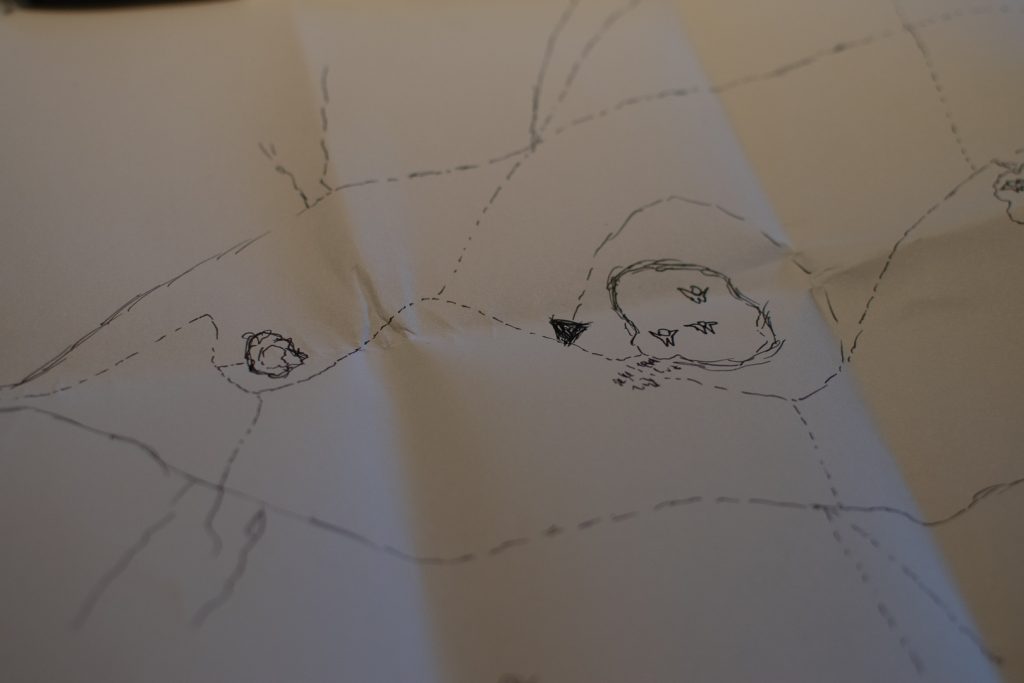
A few places in the river, I put small islands with people (people, haha, sure) on them. I used the metaphor of the island to describe the situations where I have been able to gather people together around issues of mutual concern or interest – particularly grassroots communities in education, culture and play. Over the years, these experiences have brought me immense joy and hope, and they have taught me that I am able to – occasionally maybe even good at – designing “spaces” where people feel safe enough to be present, to open up, to play and to share their vulnerabilities and insecurities. If anything I have ever done makes me proud, it is these moments.
As such, the islands represent the “wes” I have been part of assembling, the grassroots communities I have been involved in, which have (also) been a way to gain confidence and to be encouraged to continue my work.
The question is, of course, what it means to be a researcher that brings people together, that assembles a we, through the research? Intuitively, I sense that it must involve showing both humility and vulnerability, inviting questions rather than providing answers, carving out spaces for curiosity and dialogue, and maybe most important of all, being generous.
It is a way of honouring the world, and of offering something in return for the gift of existence (…)(to) join with the people and things with whom and which we share a world, allowing knowledge to grow from our correspondences with them.
Ingold, Tim (2022): Imagining for Real Essays on Creation, Attention and Correspondence, p. xii
Also, what is the shape of a thesis with the potential to cultivate a community?
I have found part of the answer during my time in Melbourne, as I met all these accomplished researchers and stellar PhD students, who all shared (at least) one trait: they were searching for ways of doing research, ways of being a researcher and even ways of living.
What made me even more hopeful than the search itself was their willingness to let it show, to almost wear it like a badge of honor. They were not trying to hide their not-knowing and their many more or less successful attempts to do things differently, but instead, they boldly included this as in their personal narrative.
As Lisa Grocott argued during a workshop I hosted at the beginning of my visit, “there is a need for a different way of doing research”. This is clearly something she herself pursues, as is evident in her new, wonderful book, “Design for Transformative Learning”.
“In stepping outside my head as a researcher, I was able to not think like an expert with answers but to instead feel like a learner with questions”
Grocott, Lisa (2022): Design for Transformative Learning – A Practical Approach to Memory-Making and Perspective-Shifting, p. xix)
Where the academic literature have given me the intellectual arguments for working and writing as I do, it is encounters with both humans and non-humans that have instilled in me a kind of embodied courage that grows from the bringing-together, when we are safe enough to let our individual vulnerabilities show. It is an ongoing practice of becoming, of finding and building courage in the encounters and communities of everyday life. I am not courageous on my own. I do not find courage in myself, neither do I find it in others, but it always only out of our being together.
The question about “the shape of a thesis” caused another fond memory to resurface, taking me entirely by surprise, as I realised that I already knew the answer, or, in the very least, one answer. Back in 2016, a member of the CounterPlay community posed a question:
“have you considered creating a CounterPlay publication focused around the outcomes of the 2016 conference? I thought it would be a great opportunity to get like minded people to write articles to form a book around our ideas on play”
My answer, not knowing any better, was yes, let us make something. It was never meant to be a book, it just turned out that way and only because we approached it playfully and so many wonderful people wanted to play along. As I reread my introduction, I suddenly realised that I already knew how to write my thesis – just like that.
The book intended to do and be many things, but first and foremost, it was an invitation to gather as a play community:
“Like the people in this book have come together, guided by their passion for play, let us do more to cultivate the global play community. (…) Let’s rise to the occasion, and do what play does best: let’s connect deeply, let’s see across the barriers and differences, let’s step into each other’s lives to join forces in the fight for a more playful world.” (Poulsen, 2017),
What this book did was to effectively assemble a we, a community, or in the very least, it strengthened the we that was already forming. It brought together people, voices, stories, personal experiences and academic research, in a messy, kaleidoscopic, but determined and hopeful manner.
Understanding this connection, between a book we created as a silly, playful con amore project and my PhD thesis, was a transformative, moving experience that literally brought tears to my eyes.
Somewhere in all these words, I am starting to see the researcher – and person – I strive to be(come): searching, probing, allowing myself to be curious, to not know exactly where I am headed or what I am doing, I hope to muster the courage to be humble, modest, vulnerable and honest, and to let it show. Always.
I have said repeatedly over the years that I don’t have personal ambitions in terms of what some would call a career. This remains true, but that is only because I much prefer the ambitions, hopes and dreams that can be shared, those that grow from the encounters between us (it also takes a certain kind of privilege to take this stance, I know). I don’t care about competition, I actively dislike it, but conversation is everything.
“Dialogue cannot exist, however, in the absence of a profound love for the world and for people. (…) If I do not love the world—if I do not love life—if I do not love people—I cannot enter into dialogue”
Freire, Paulo (2000): Pedagogy of the Oppressed, pp. 89-90
I hope that this attitude will show in the work itself, and, more importantly, that it might open up the research, bring you in closer, and, ideally, begin to assemble a we around, between and with the words and the questions they may spark. If I can gather just a few people around this metaphorical bonfire to share our stories, if we can encourage each other and move on to new adventures together, I can hope for no more.
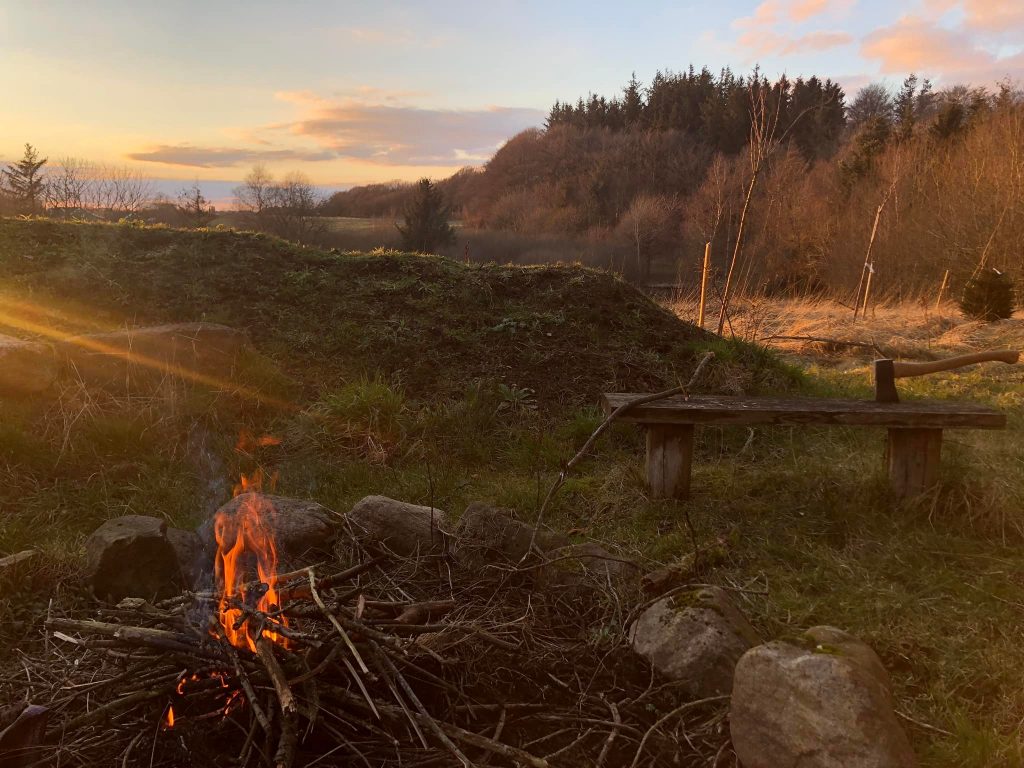
As this text was coming together, as the letters, words and sentences assembled as a we on the screen, I was reinvigorated, joyful, suddenly more confident that there was, there is, after all, a meaningful contribution to be made and by me, no less. Not merely by the experiments I have conducted, or the theoretical arguments that I am modestly and slowly trying to give shape, but by the mere possibility that a we could assemble around it all.
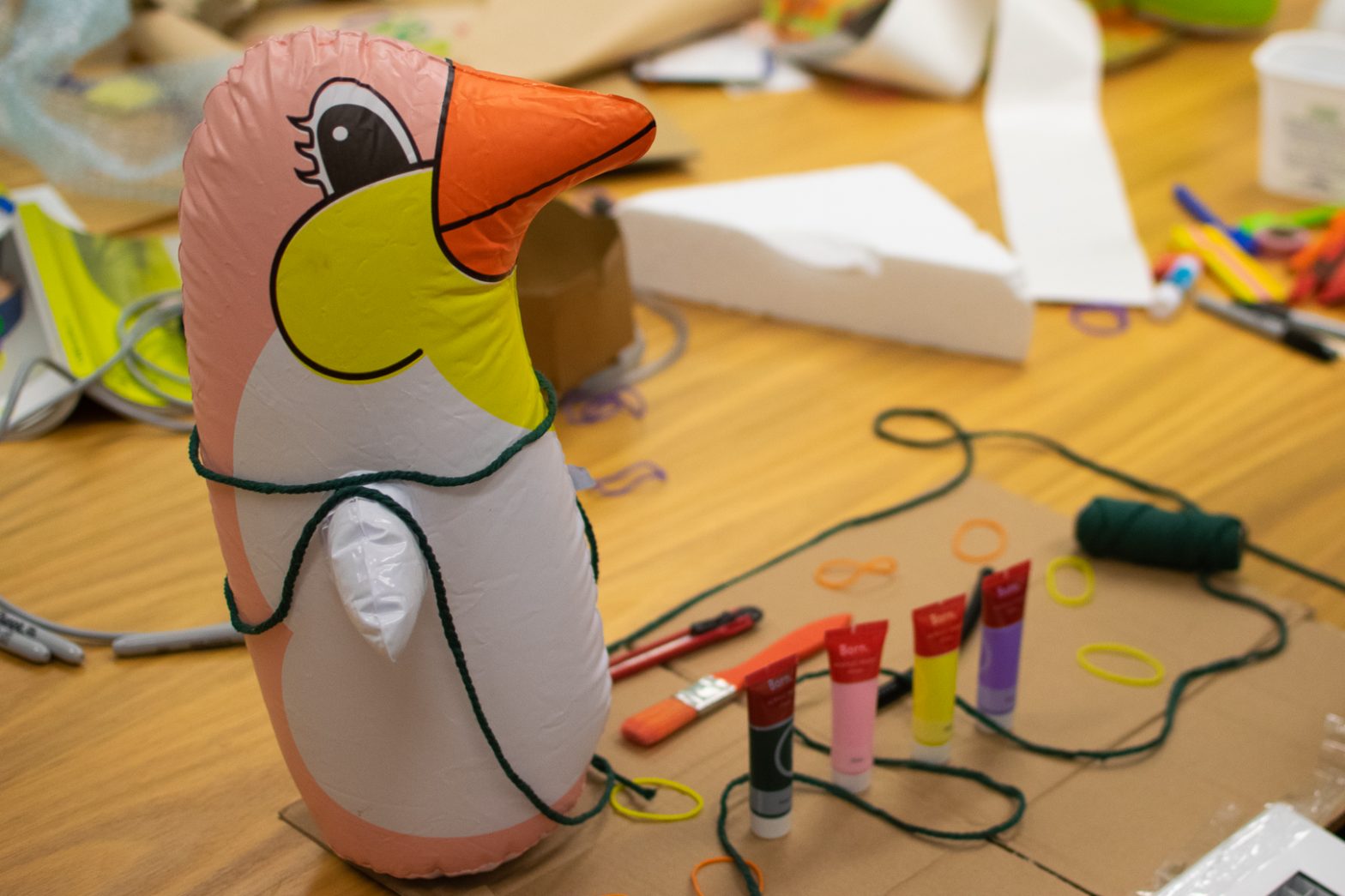
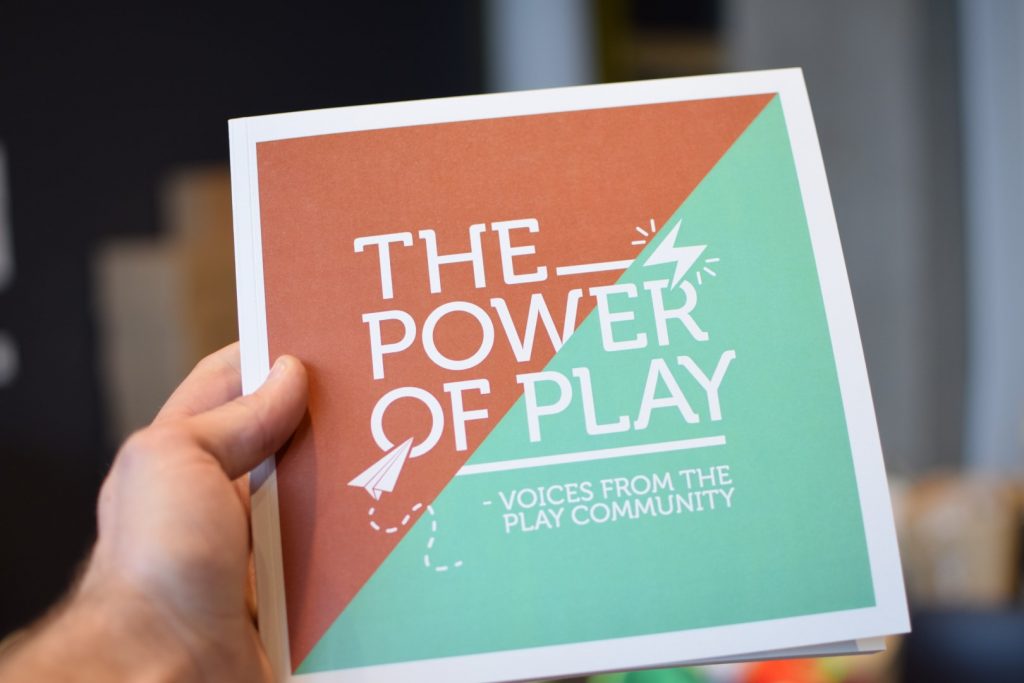
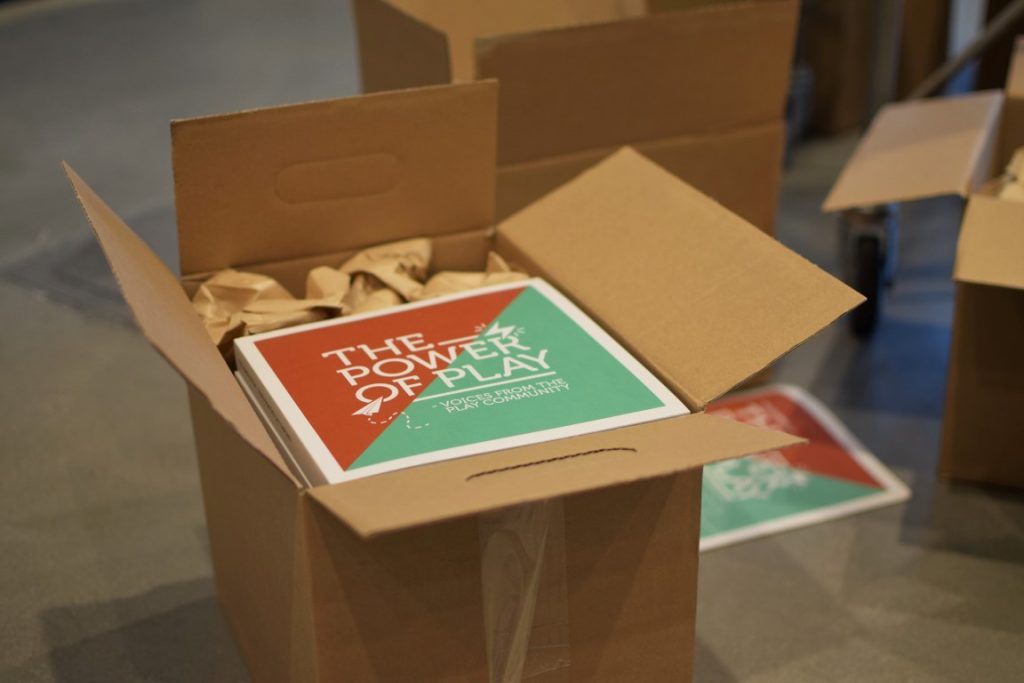
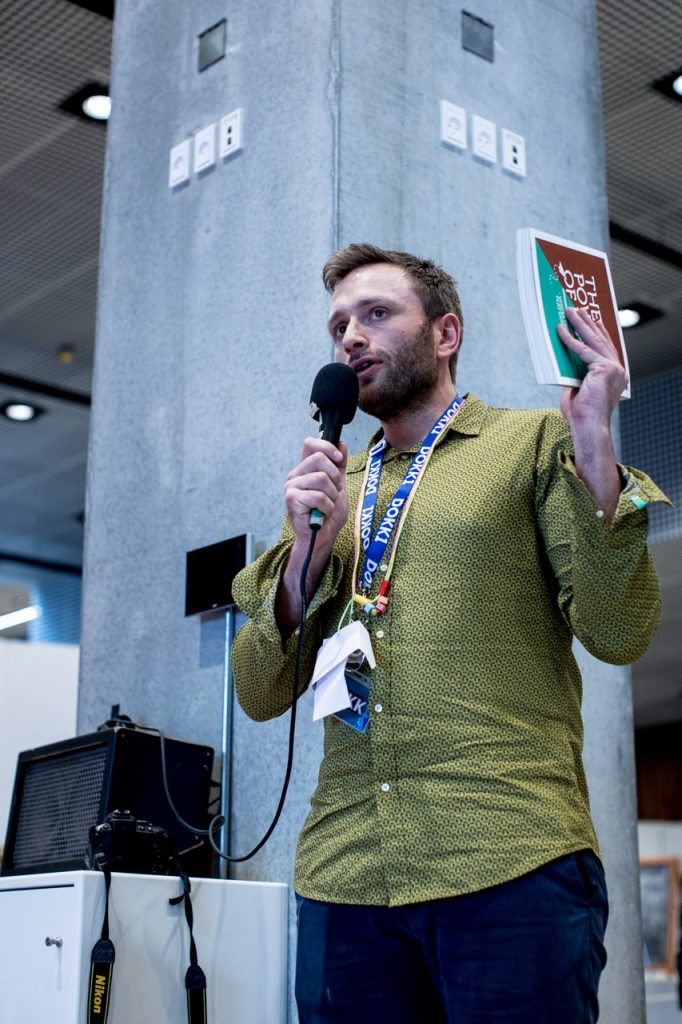
Leave a Reply